Anion Coordination into Ligand Clefts
Abstract
1. Introduction
2. Materials and Methods
2.1. General
2.2. Synthesis of HL (HL∙EtOH∙H2O)
2.3. Synthesis of H3L(ClO4)2∙H2O
2.4. Synthesis of H3L(ReO4)2
2.5. Potentiometric Measurements
2.6. Spectroscopic Measurements
2.7. Single-Crystal X-ray Diffraction Analyses
2.8. Hirshfeld Surface Analysis
3. Results and Discussion
3.1. Ligand Protonation
3.2. Crystallographic Study
3.2.1. Crystal Structure of HL∙EtOH∙H2O
3.2.2. Crystal Structures of the Anion Cleft Complexes H3L(ReO4)2 and H3L(ClO4)2·H2O
3.2.3. FT-IR Spectra Analysis
3.2.4. Hirshfeld Surface Analysis
4. Conclusions
Supplementary Materials
Author Contributions
Funding
Data Availability Statement
Acknowledgments
Conflicts of Interest
References
- Bianchi, A.; Bowman-James, K.; Garcia-España, E. (Eds.) Supramolecular Chemistry of Anions; Wiley-VCH: New York, NY, USA, 1997. [Google Scholar]
- Sessler, J.L.; Gale, P.A.; Cho, W.S. Anion Receptor Chemistry (Monographs in Supramolecular Chemistry); RSC Publishing: Cambridge, UK, 2006. [Google Scholar]
- Bowman-James, K.; Bianchi, A.; Garcia-España, E. (Eds.) Anion Coordination Chemistry; Wiley-VCH: New York, NY, USA, 2012. [Google Scholar]
- Zhao, J.; Yang, D.; Yang, X.-J.; Wu, B. Anion coordination chemistry: From recognition to supramolecular assembly. Coord. Chem. Rev. 2019, 378, 415–444. [Google Scholar] [CrossRef]
- He, Q.; Tu, P.; Sessler, J.L. Supramolecular Chemistry of Anionic Dimers, Trimers, Tetramers, and Clusters. Chem 2018, 4, 46–93. [Google Scholar] [CrossRef] [PubMed]
- Custelcean, R. Anion encapsulation and dynamics in self-assembled coordination cages. Chem. Soc. Rev. 2014, 43, 1813–1824. [Google Scholar] [CrossRef] [PubMed]
- Bowman-James, K. Alfred Werner Revisited: The Coordination Chemistry of Anions. Acc. Chem. Res. 2005, 38, 671–678. [Google Scholar] [CrossRef]
- Ilioudis, C.A.; Steed, J.W. Organic macrocyclic polyamine-based receptors for anions. J. Supramol. Chem. 2001, 1, 165–187. [Google Scholar] [CrossRef]
- Llinares, J.M.; Powell, D.; Bowman-James, K. Ammonium based anion receptors. Coord. Chem. Rev. 2003, 240, 57–75. [Google Scholar] [CrossRef]
- Gale, P.A. Anion receptor chemistry: Highlights from 1999. Coord. Chem. Rev. 2001, 213, 79–128. [Google Scholar] [CrossRef]
- Dietrich, B. Design of anion receptors: Applications. Pure Appl. Chem. 1993, 65, 1457–1464. [Google Scholar] [CrossRef]
- Bazzicalupi, C.; Bencini, A.; Bianchi, A.; Danesi, A.; Giorgi, C.; Valtancoli, B. Anion Binding by Protonated Forms of the Tripodal Ligand Tren. Inorg. Chem. 2009, 48, 2391–2398. [Google Scholar] [CrossRef]
- García-Martín, J.; López-Garzón, R.; Godino-Salido, M.L.; Cuesta, R.; Gutiérrez-Valero, M.D.; Arranz-Mascarós, P.; Stoeckli-Evans, H. Adsorption of Zn2+ and Cd2+ from Aqueous Solution onto a Carbon Sorbent Containing a Pyrimidine–Polyamine Conjugate as Ion Receptor. Eur. J. Inorg. Chem. 2005, 2005, 3093–3103. [Google Scholar] [CrossRef]
- Arranz, P.; Bianchi, A.; Cuesta, C.; Giorgi, C.; Godino, M.L.; Gutiérrez, M.D.; López, R.; Santiago, A. Binding and Removal of Sulfate, Phosphate, Arsenate, Tetrachloromercurate, and Chromate in Aqueous Solution by Means of an Activated Carbon Functionalized with a Pyrimidine-Based Anion Receptor (HL). Crystal Structures of [H3L(HgCl4)]3∙H2O and [H3L(HgBr4)]3∙H2O Showing Anion-π Interactions. Inorg. Chem. 2010, 49, 9321–9332. [Google Scholar]
- Arranz, P.; Bazzicalupi, C.; Bianchi, A.; Giorgi, C.; Godino, M.L.; Gutiérrez, M.D.; López, R.; Savastano, M. Thermodynamics of Anion−π Interactions in Aqueous Solution. J. Am. Chem. Soc. 2013, 135, 102–105. [Google Scholar] [CrossRef] [PubMed]
- Savastano, M.; Arranz, P.; Bazzicalupi, C.; Bianchi, A.; Giorgi, C.; Godino, M.L.; Gutiérrez, M.D.; López, R. Binding and removal of octahedral, tetrahedral, square planar and linear anions in water by means of activated carbon functionalized with a pyrimidine-based anion receptor. RSC Adv. 2014, 4, 58505–58513. [Google Scholar] [CrossRef]
- Savastano, M.; Arranz-Mascarós, P.; Bazzicalupi, C.; Clares, M.P.; Godino-Salido, M.L.; Gutiérrez-Valero, M.D.; Guijarro, L.; Bianchi, A.; Garcia-España, E.; López-Garzón, R. Polyfunctional Tetraaza-Macrocyclic Ligands: Zn(II), Cu(II) Binding and Formation of Hybrid Materials with Multiwalled Carbon Nanotubes. ACS Omega 2017, 2, 3868–3877. [Google Scholar] [CrossRef] [PubMed]
- Kou, X.; Ma, Y.; Pan, C.; Huang, Y.; Duan, Y.; Yang, Y. Effects of the Cationic Structure on the Adsorption Performance of Ionic Polymers toward Au(III): An Experimental and DFT Study. Langmuir 2022, 38, 6116–6127. [Google Scholar] [CrossRef] [PubMed]
- Xu, Y.; Dang, D.; Zhang, N.; Zhang, J.; Xu, R.; Wang, Z.; Zhou, Y.; Zhang, H.; Liu, H.; Yang, Z.; et al. Aggregation-Induced Emission (AIE) in Superresolution Imaging: CXationic AIE Luminogens (AIEgens) for Tunable Organelle-Specific Imaging and Dynamic Tracking in Nanometer Scale. ACS Nano 2022, 16, 5932–5942. [Google Scholar] [CrossRef] [PubMed]
- Das, A.; Sharma, P.; Frontera, A.; Verma, A.K.; Barcelo-Oliver, M.; Hussain, S.; Bhattacharyya, M.K. Energetically significant nitrile···nitrile and unconventional C–H···π(nitrile) interactions in pyridine based Ni(II) and Zn(II) coordination compounds: Antiproliferative evaluation and theoretical studies. J. Mol. Struct. 2021, 1223, 129246. [Google Scholar] [CrossRef]
- Qi, B.; An, S.; Luo, J.; Liu, T.; Song, Y.-F. Enhanced Macroanion Recognition of Superchaotropic Keggin Clusters Achieved by Synergy of Anion–π and Anion–Cation Interactions. Chem. Eur. J. 2020, 26, 16802–16810. [Google Scholar] [CrossRef]
- Martínez-Camarena, Á.; Savastano, M.; Bazzicalupi, C.; Bianchi, A.; García-España, E. Stabilisation of Exotic Tribromide (Br3−) Anions via Supramolecular Interaction with a Tosylated Macrocyclic Pyridinophane. A Serendipitous Case. Molecules 2020, 25, 3155. [Google Scholar] [CrossRef]
- Savastano, M.; Bazzicalupi, C.; Gellini, C.; Bianchi, A. Infinite supramolecular pseudo-polyrotaxane with poly[3]catenane axle: Assembling nanosized rings from mono- and diatomic I− and I2 tectons. Chem. Commun. 2020, 56, 551–554. [Google Scholar] [CrossRef]
- Savastano, M.; Bazzicalupi, C.; Gellini, C.; Bianchi, A. Genesis of complex polyiodide networks: Insights on the blue box/I−/I2 ternary system. Crystals 2020, 10, 387. [Google Scholar] [CrossRef]
- Savastano, M.; Bazzicalupi, C.; Bianchi, A. Porous frameworks based on supramolecular ball joints: Bringing flexibility to ordered 3D lattices. Chem. Eur. J. 2020, 26, 5994–6005. [Google Scholar] [CrossRef] [PubMed]
- Giese, M.; Albrecht, M.; Repenko, T.; Sackmann, J.; Valkonen, A.; Rissanen, K. Single-Crystal X-ray Diffraction and Solution Studies of Anion–π Interactions in N-(Pentafluorobenzyl)pyridinium Salts. Eur. J. Org. Chem. 2014, 2014, 2435–2442. [Google Scholar] [CrossRef]
- Biswas, C.; Drew, M.G.B.; Escudero, D.; Frontera, A.; Ghosh, A. Anion–π, Lone-Pair–π, π–π and Hydrogen-Bonding Interactions in a CuII Complex of 2-Picolinate and Protonated 4,4′-Bipyridine: Crystal Structure and Theoretical Studies. Eur. J. Inorg. Chem. 2009, 2009, 2238–2246. [Google Scholar] [CrossRef]
- de Hoog, P.; Gamez, P.; Mutikainen, I.; Turpeinen, U.; Reedijk, J. An Aromatic Anion Receptor: Anion–p Interactions do Exist. Angew. Chem. Int. Ed. 2004, 43, 5815–5817. [Google Scholar] [CrossRef]
- Krishnan Suresh, K.; Subbiah, K.; Kalivel, P.; Ayyasamy, S.; Palanivel, S. Environmental occurrence, toxicity and remediation of perchlorate—A review. Chemosphere 2023, 311, 137017. [Google Scholar]
- Shukla, M.K.; Boddu, V.M.; Steevens, J.A.; Damavarapu, R.; Leszczynski, J. (Eds.) Energetic Materials: From Cradle to Grave. In Challenges and Advances in Computational Chemistry and Physics; Springer: Berlin/Heidelberg, Germany, 2018; Volume 25. [Google Scholar]
- Vogt, H.; Balej, J.; Bennett, J.E.; Wintzer, P.; Sheikh, S.A.; Gallone, P. Chlorine Oxides and Chlorine Oxygen Acids. In Ullmann’s Encyclopedia of Industrial Chemistry; Wiley-VCH: New York, NY, USA, 2002. [Google Scholar]
- Gu, B.; Coates, J.D. (Eds.) Perchlorate. Environmental Occurrence, Interactions and Treatment; Springer Nature: Berlin/Heidelberg, Germany, 2006. [Google Scholar]
- Da, H.-J.; Yang, C.-X.; Yan, X.-P. Cationic Covalent Organic Nanosheets for Rapid and Selective Capture of Perrhenate: An Analogue of Radioactive Pertechnetate from Aqueous Solution. Environ. Sci. Technol. 2019, 53, 5212–5220. [Google Scholar] [CrossRef]
- Kohlickova, M.; Jedinakova-Krizova, V.; Melichar, F. Rhenium complexes in nuclear medicine. Chem. Listy 2000, 94, 151–158. [Google Scholar]
- Volkert, W.A.; Hoffman, T.J. Therapeutic Radiopharmaceuticals. Chem. Rev. 1999, 99, 2269–2292. [Google Scholar] [CrossRef]
- Colton, R. The Chemistry of Rhenium and Technetium, 1st ed.; John Wiley and Sons Ltd.: Hoboken, NJ, USA; Interscience Publishers: New York, NY, USA, 1965. [Google Scholar]
- Banerjee, D.; Kim, D.; Schweiger, M.J.; Krugerc, A.A.; Thallapally, P.K. Removal of TcO4− ions from solution: Materials and future outlook. Chem. Soc. Rev. 2016, 45, 2724–2739. [Google Scholar] [CrossRef]
- Katayev, E.A.; Kolesnikov, G.V.; Sessler, J.L. Molecular recognition of pertechnetate and perrhenate. Chem. Soc. Rev. 2009, 38, 1572–1586. [Google Scholar] [CrossRef] [PubMed]
- Gale, P.A.; Howe, N.W.; Wu, X. Anion Receptor Chemistry. Chem 2016, 1, 351–422. [Google Scholar] [CrossRef]
- Zhou, W.; Li, A.; Gale, P.A.; He, Q. A highly selective superphane for ReO4− recognition and extraction. Cell Rep. Phys. Sci. 2022, 3, 100875. [Google Scholar] [CrossRef]
- Macreadie, L.K.; Gilchrist, A.M.; McNaughton, D.A.; Ryder, W.G.; Fares, M.; Gale, P.A. Progress in anion receptor chemistry. Chem 2022, 8, 46–118. [Google Scholar] [CrossRef]
- Low, N.J.; López, M.D.; Arranz, P.; Cobo, J.; Godino, M.L.; López, R.; Gutiérrez, M.D.; Melguizo, M.; Ferguson, G.; Glidewell, C. N-(6-Amino-3,4-dihydro-3-methyl-5-nitroso-4-oxopyrimidin-2-yl) derivatives of glycine, valine, serine, threonine and methionine: Interplay of molecular, molecular-electronic and supramolecular structures. Acta Cryst. B 2000, 56, 882–892. [Google Scholar] [CrossRef]
- Bazzicalupi, C.; Bianchi, A.; Biver, T.; Giorgi, C.; Santarelli, S.; Savastano, M. Formation of double-strand dimetallic helicates with a terpyridine-based macrocycle. Inorg. Chem. 2014, 53, 12215–12224. [Google Scholar] [CrossRef]
- Fontanelli, M.; Micheloni, M. Proceedings of the I Spanish-Italian Congress on Thermodynamics of Metal Complexes; Diputación de Castellón: Castellón, Spain, 1990; pp. 41–43. [Google Scholar]
- Savastano, M.; Fiaschi, M.; Ferraro, G.; Gratteri, P.; Mariani, P.; Bianchi, A.; Bazzicalupi, C. Sensing Zn2+ in Aqueous Solution with a Fluorescent Scorpiand Macrocyclic Ligand Decorated with an Anthracene Bearing Tail. Molecules 2020, 25, 1355. [Google Scholar] [CrossRef]
- Gran, G. Determination of the equivalence point in potentiometric titrations. Part II. Analyst 1952, 77, 661–671. [Google Scholar] [CrossRef]
- Gans, P.; Sabatini, A.; Vacca, A. Investigation of equilibria in solution. Determination of equilibrium constants with the HYPERQUAD suite of programs. Talanta 1996, 43, 1739–1753. [Google Scholar] [CrossRef]
- Krause, L.; Herbst-Irmer, R.; Sheldrick, G.M.; Stalke, D. Comparison of silver and molybdenum microfocus X-ray sources for single-crystal structure determination. J. Appl. Cryst. 2015, 48, 3–10. [Google Scholar] [CrossRef]
- Sheldrick, G.M. A short history of SHELX. Acta Crystallogr. A 2008, 64, 112–122. [Google Scholar] [CrossRef] [PubMed]
- Sheldrick, G.M. Crystal structure refinement with SHELXL. Acta Cryst. 2015, C71, 3–8. [Google Scholar]
- Turner, M.J.; McKinnon, J.J.; Wolff, S.K.; Grimwood, D.J.; Spackman, P.R.; Jayatilaka, D.; Spackman, M.A. CrystalExplorer17; University of Western Australia: Crawley, WA, Australia, 2017; Available online: https://crystalexplorer.net (accessed on 6 February 2023).
- Savastano, M.; Arranz-Mascarós, P.; Clares, M.P.; Cuesta, R.; Godino-Salido, M.L.; Guijarro, L.; Gutiérrez-Valero, M.D.; Inclán, M.; Bianchi, A.; García-España, E.; et al. A new heterogeneous catalyst obtained via supramolecular decoration of graphene with a Pd2+ azamacrocyclic complex. Molecules 2019, 24, 2714. [Google Scholar] [CrossRef] [PubMed]
- Savastano, M.; Arranz-Mascarós, P.; Bazzicalupi, C.; Clares, M.P.; Godino-Salido, M.L.; Gutiérrez-Valero, M.D.; Inclán, M.; Bianchi, A.; Garcia-España, E.; López-Garzón, R. Construction of green nanostructured heterogeneous catalysts via non-covalent surface decoration of multi-walled carbon nanotubes with Pd(II) complexes of azamacrocycles. J. Catal. 2017, 353, 239–249. [Google Scholar] [CrossRef]
- Godino-Salido, M.-L.; Santiago-Medina, A.; Arranz-Mascarós, P.; López-Garzón, R.; Gutiérrez-Valero, M.D.; Melguizo, M.; López-Garzón, F.J. Novel active carbon/crown ether derivative hybrid material for the selective removal of Cu(II) ions: The crucial role of the surface chemical functions. Chem. Eng. Sci. 2014, 114, 94–104. [Google Scholar] [CrossRef]
- Savastano, M.; Passaponti, M.; Giurlani, W.; Lari, L.; Bianchi, A.; Innocenti, M. Multi-Walled Carbon Nanotubes Supported Pd(II) Complexes: A Supramolecular Approach towards Single-Ion Oxygen Reduction Reaction Catalysts. Energies 2020, 13, 5539. [Google Scholar] [CrossRef]
- Hughes, E.B.; Jellinek, H.H.G.; Ambrose, B.A. Pyridine. Ultraviolet Absorption Spectrum and Dissociation Constant. J. Phys. Chem. 1949, 53, 410–414. [Google Scholar] [CrossRef]
- Daolio, A.; Pizzi, A.; Terraneo, G.; Frontera, A.; Resnati, G. Anion∙∙∙Anion Interaction involving σ-Holes of Perrhenate, Pertechnetate and Permanganate Anions. ChemPhysChem 2021, 22, 2281–2285. [Google Scholar] [CrossRef]
- Gomila, R.M.; Frontera, A. Matere Bonds vs. Multivalent Halogen and Chalcogen Bonds: Three Case Studies. Molecules 2022, 27, 6597. [Google Scholar] [CrossRef]
- Nyquist, R.A.; Kagel, R.O. Infrared and Raman Spectra of Inorganic Compounds and Organic Salts, 2nd ed.; Academic Press: New York, NY, USA, 1971. [Google Scholar]
- Sima, L.H.; Ganb, S.N.; Chana, C.H.; Yahyab, R. ATR-FTIR studies on ion interaction of lithium perchlorate in polyacrylate/poly(ethylene oxide) blends. Spectrochim. Acta Part A 2010, 76, 287–292. [Google Scholar] [CrossRef]
- Chandrawanshi, S.; Verma, S.K.; Deb, M.K. Collective Ion-Pair Single-Drop Microextraction Attenuated Total Reflectance Fourier Transform Infrared Spectroscopic Determination of Perchlorate in Bioenvironmental Samples. J. AOAC Int. 2018, 101, 1145–1155. [Google Scholar] [CrossRef] [PubMed]
- Hori, K.; Iwama, A.; Fukuda, T. FTIR Spectroscopic Study on the Interaction between Ammonium Perchlorate and Bonding Agents. Propell. Explos. Pyrot. 1990, 15, 99–102. [Google Scholar] [CrossRef]
- Gonzalez-Rodriguez, J.; Pepper, K.; Baron, M.G.; Mamo, S.K.; Simons, A.M. Production and Analysis of Recycled Ammonium Perrhenate from CMSX-4 superalloys. Open Chem. 2018, 16, 1298–1306. [Google Scholar] [CrossRef]
- Gassman, P.-L.; McCloy, J.S.; Soderquist, C.Z.; Schweiger, M.J. Raman analysis of perrhenate and pertechnetate in alkali salts and borosilicate glasses. J. Raman Spectrosc. 2014, 45, 139–147. [Google Scholar] [CrossRef]
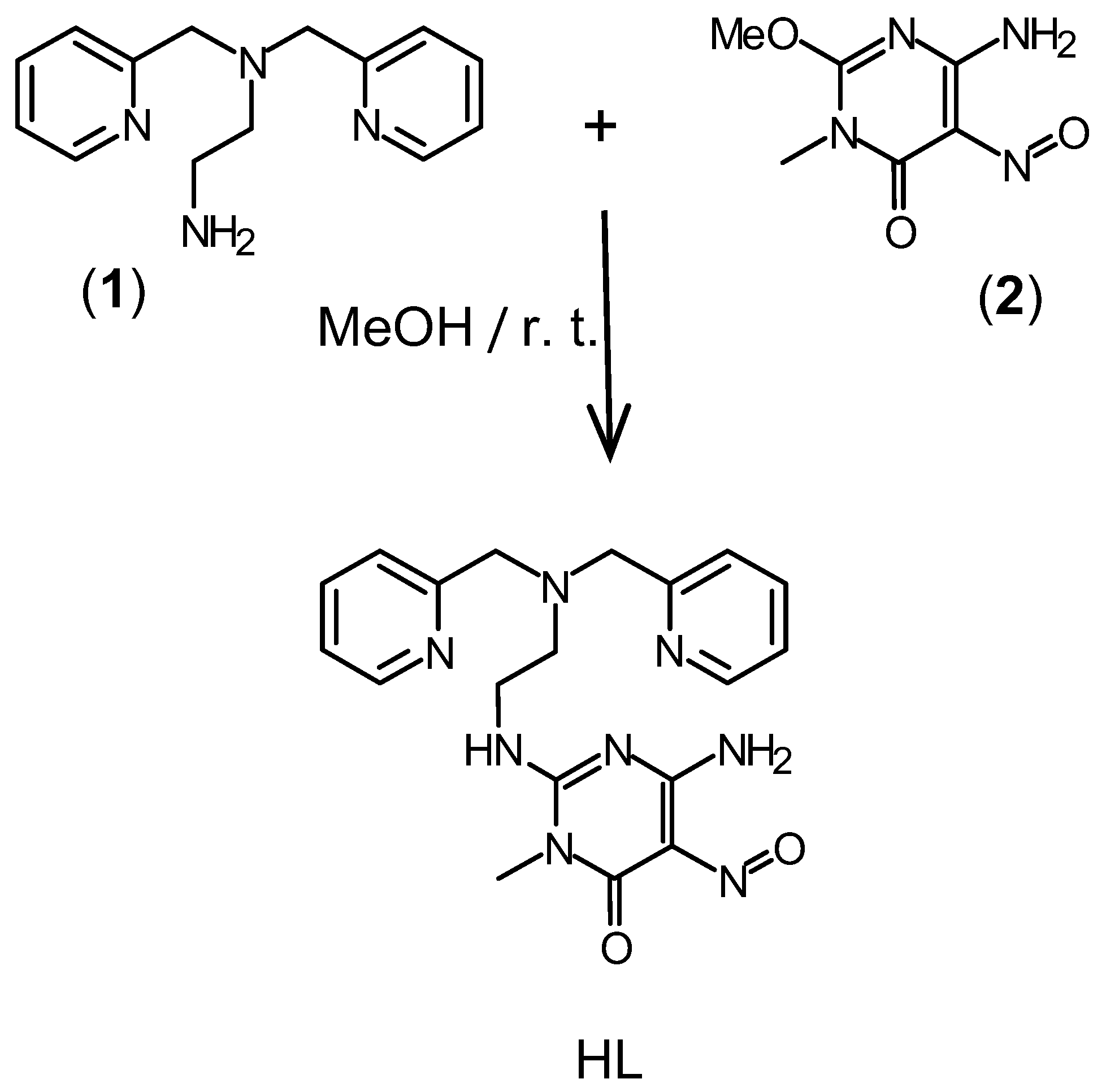
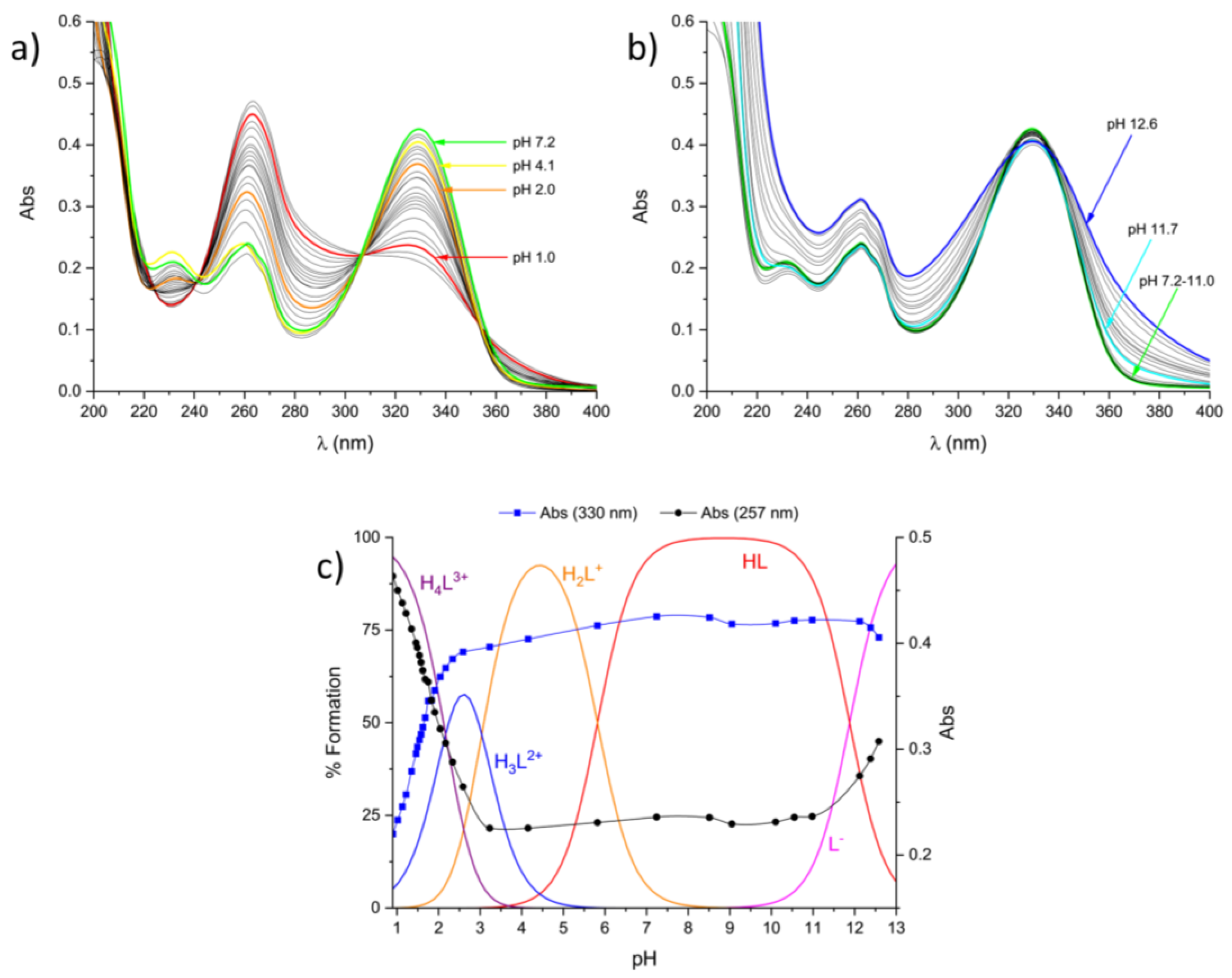
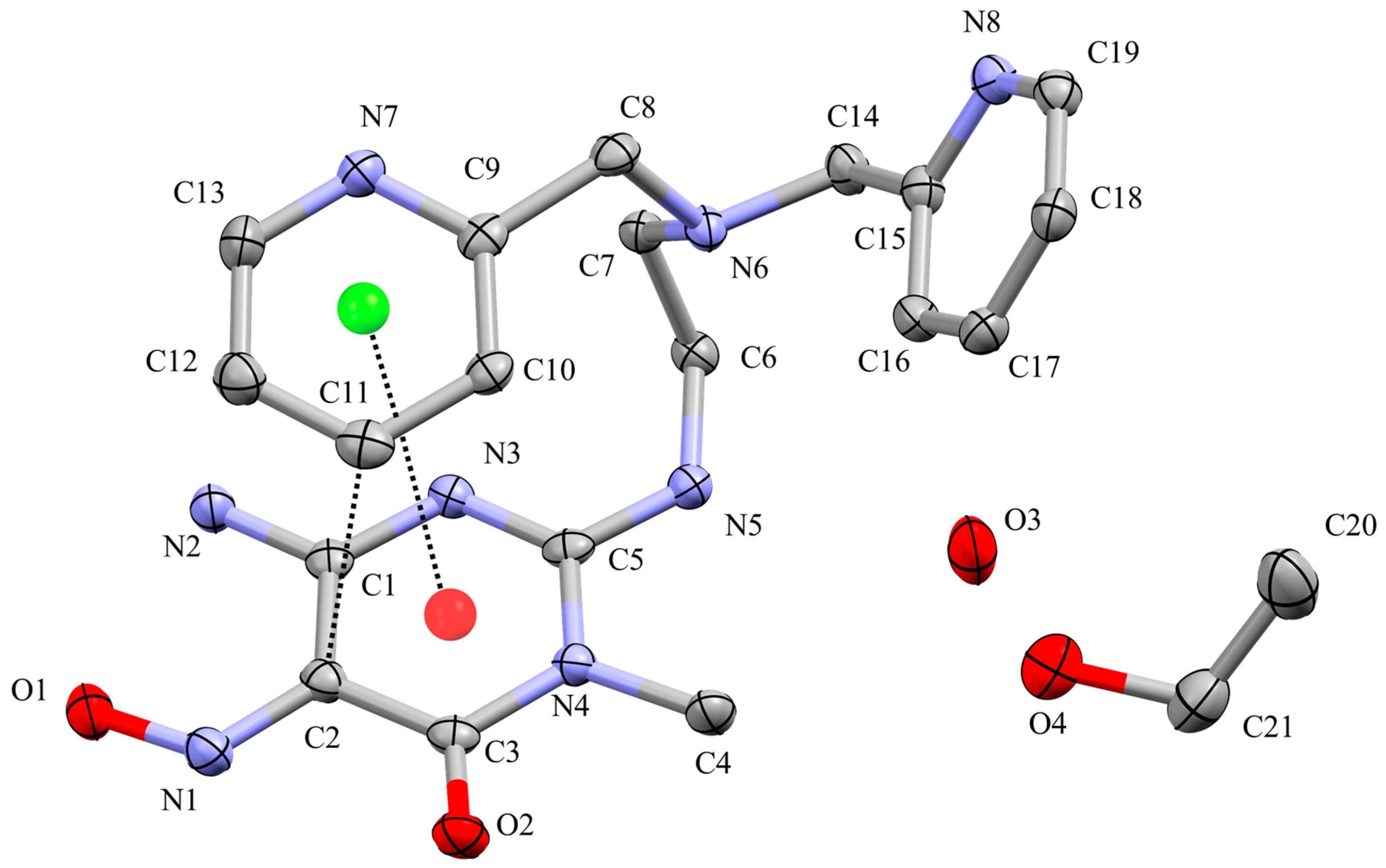
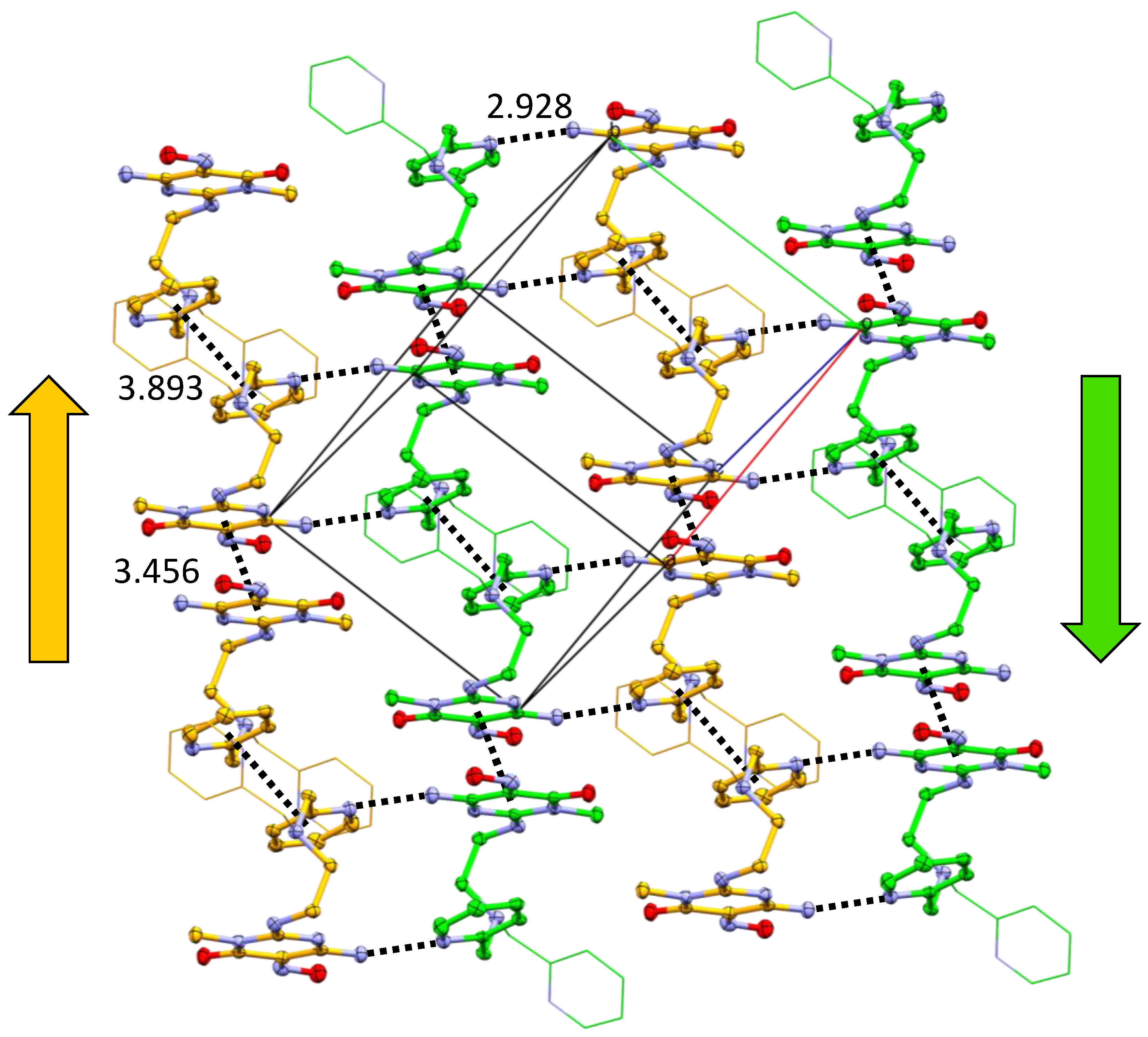

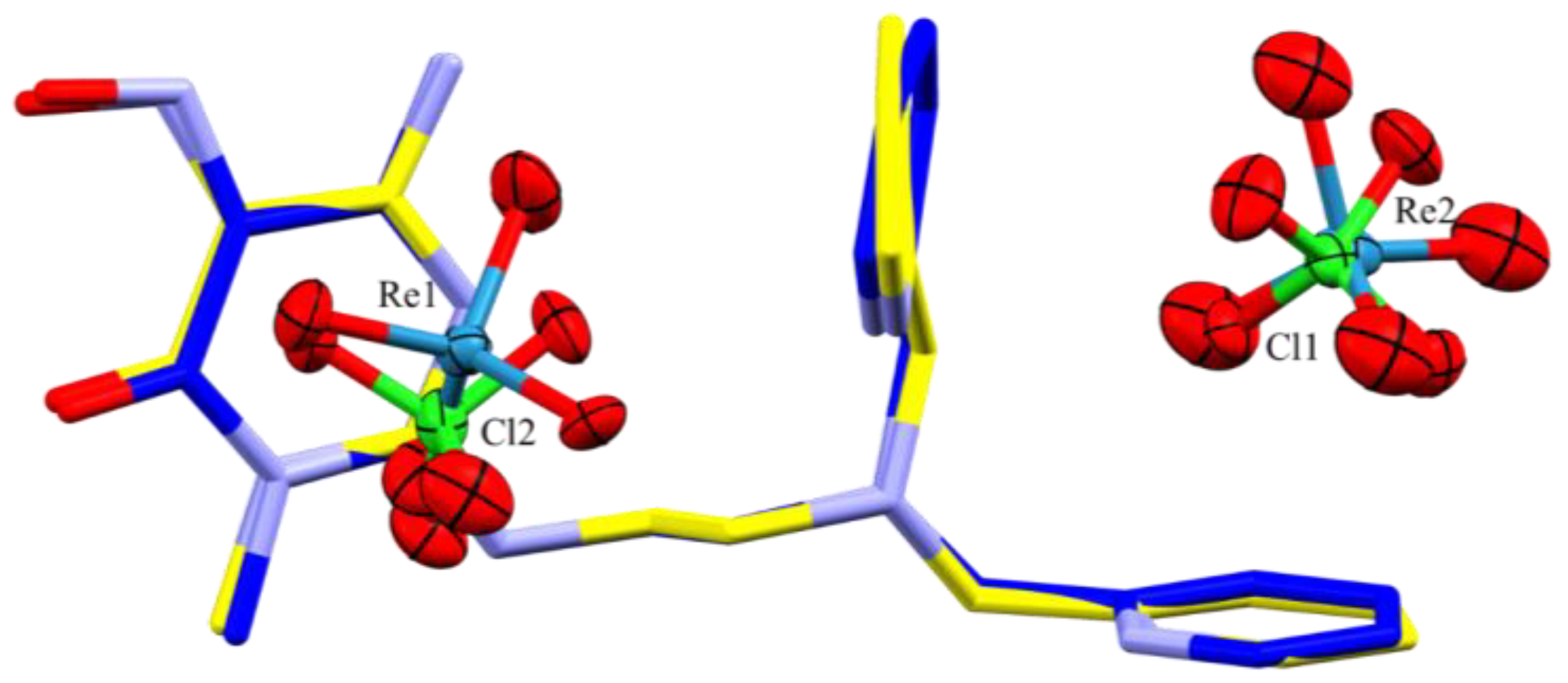
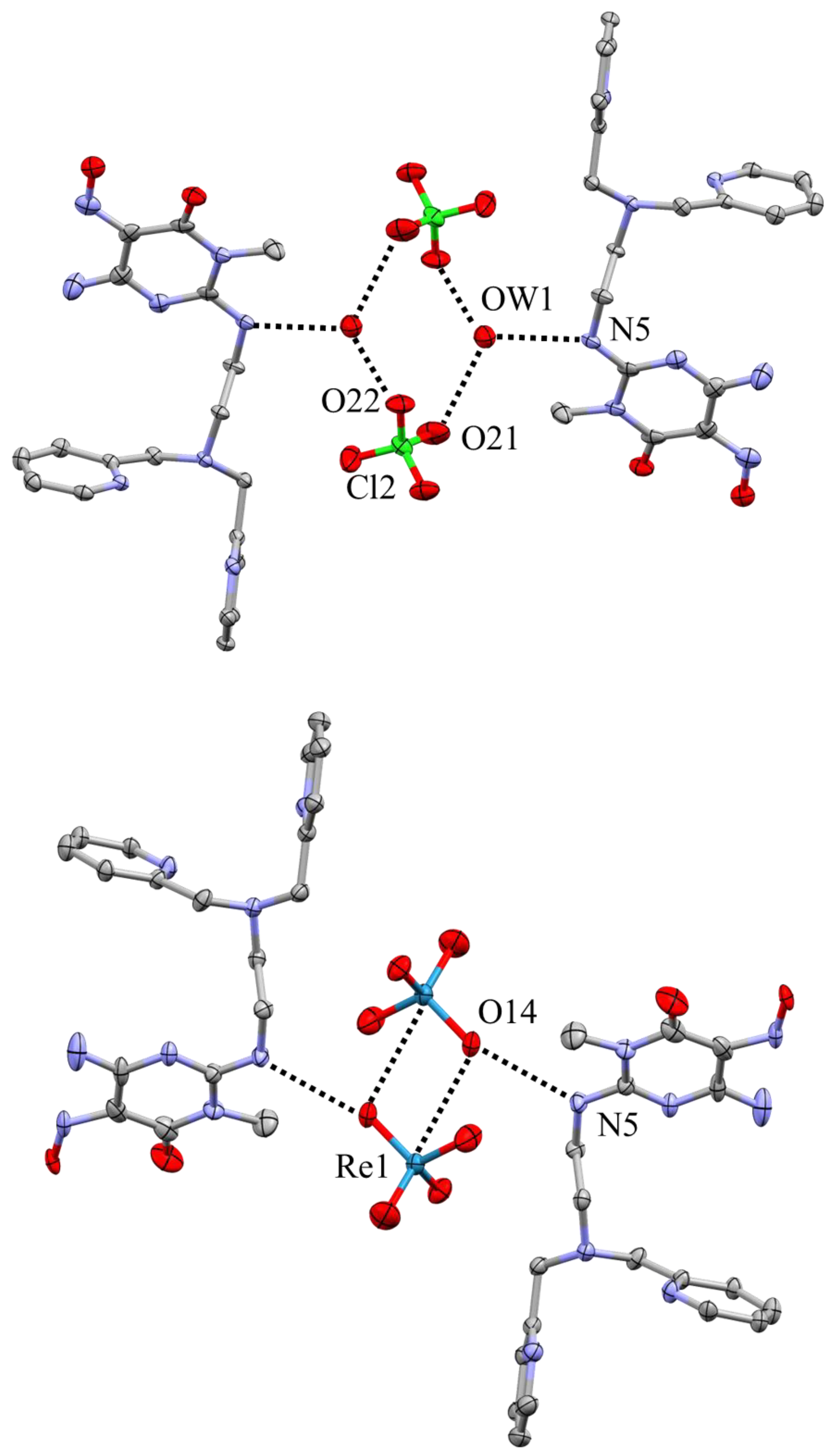
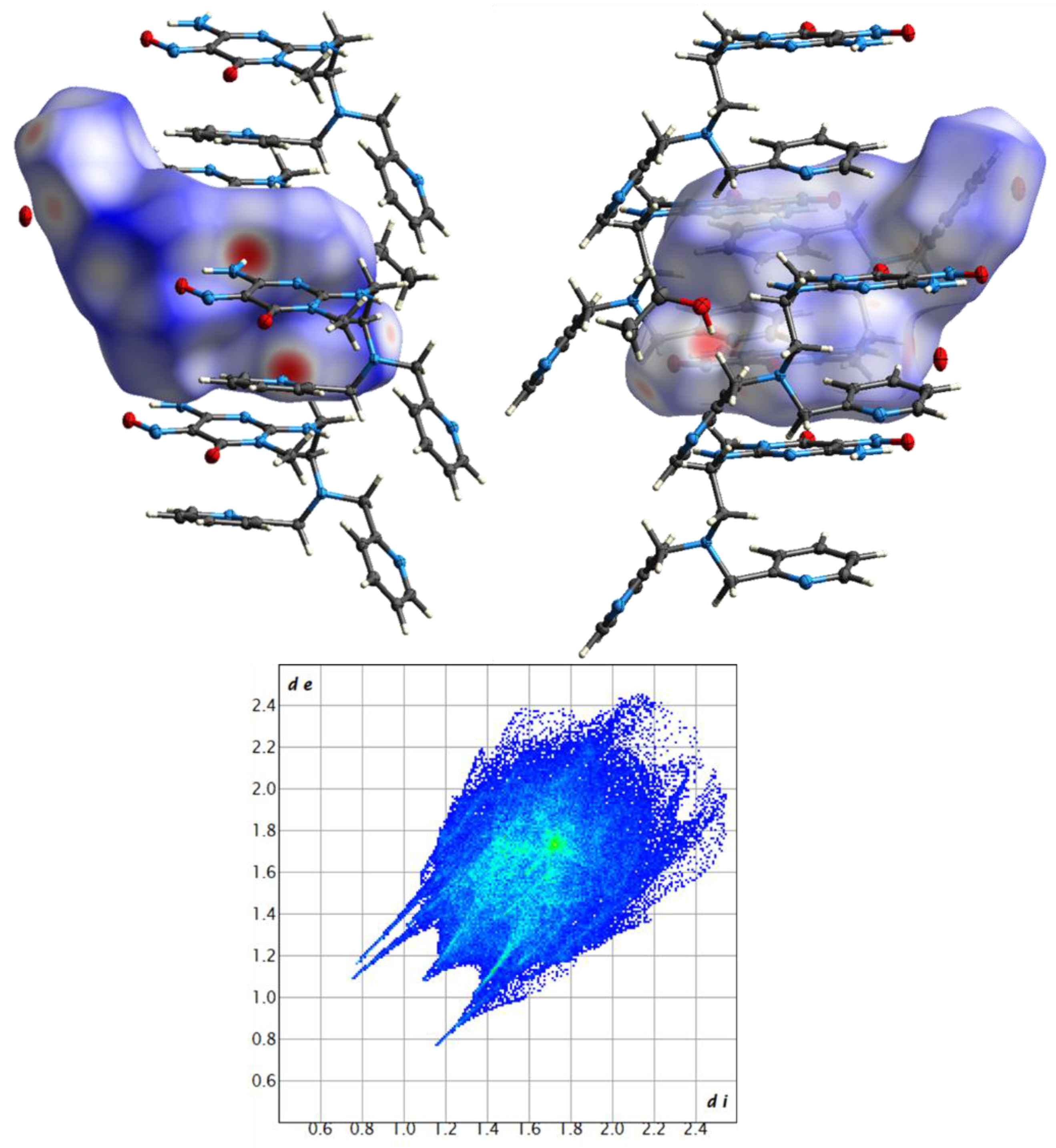
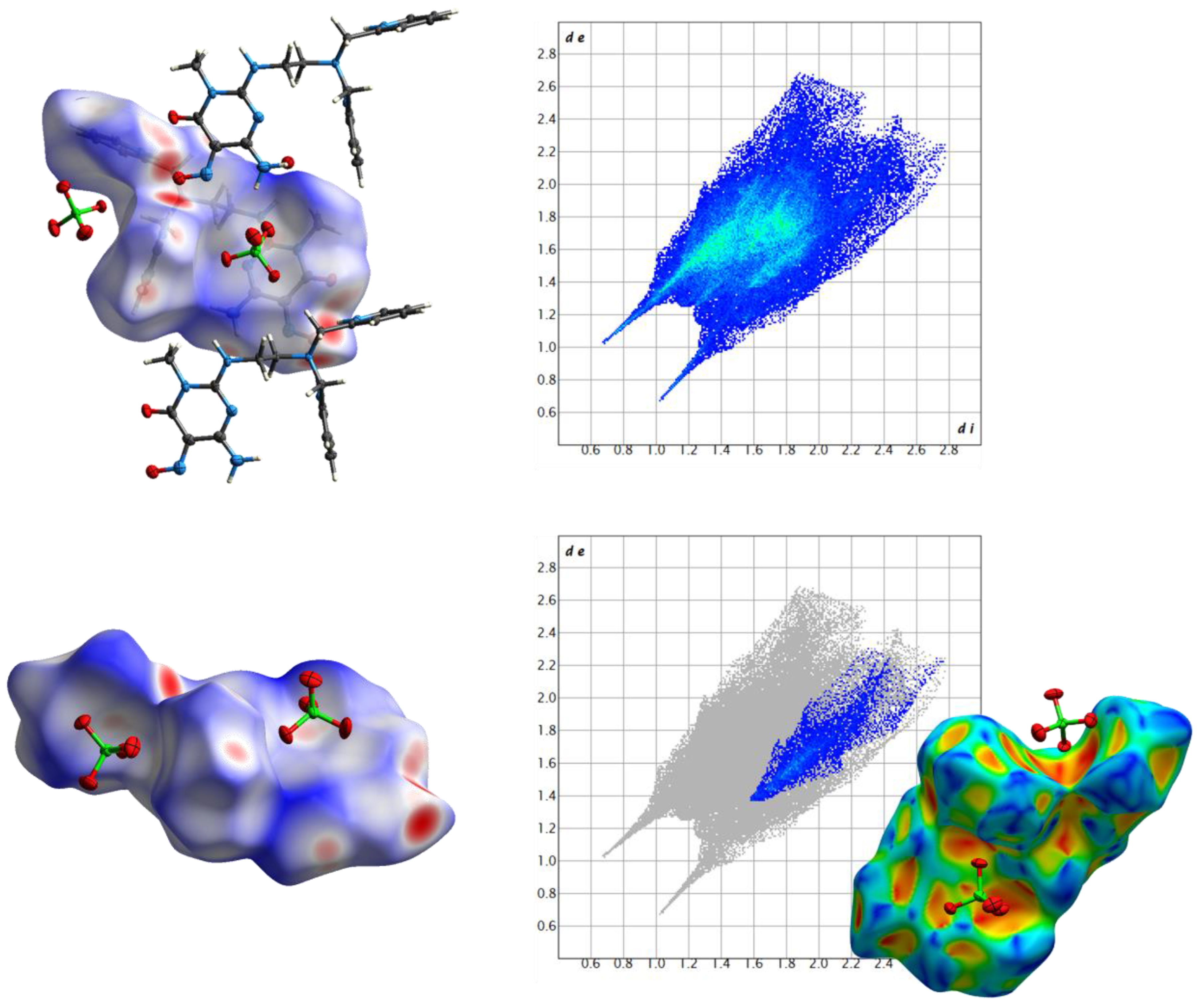

| HL∙EtOH∙H2O | H3L(ReO4)2 | H3L(ClO4)2·H2O | |
|---|---|---|---|
| Empirical formula | C21H30N8O4 | C19H24N8O10Re2 | C19H26Cl2N8O11 |
| Formula weight | 458.53 | 896.86 | 613.38 |
| Temperature (K) | 100(2) | 100(2) | 100(2) |
| space group | P-1 | P21/n | P21/n |
| a (Å) | 9.3960(4) | 14.9381(9) | 13.8500(5) |
| b (Å) | 9.7782(4) | 12.8194(6) | 13.2210(5) |
| c (Å) | 13.6308(6) | 14.9659(7) | 15.3154(6) |
| α (°) | 76.058(2) | 90 | 90 |
| β (°) | 70.650(2) | 115.548(2) | 113.661(2) |
| γ (°) | 89.521(2) | 90 | 90 |
| Volume (Å3) | 1143.29(9) | 2585.7(2) | 2568.67(17) |
| Z | 2 | 4 | 4 |
| Independent reflections/R(int) | 3500/0.1297 | 12,541/0.0662 | 4670/0.0583 |
| μ (mm−1) | 0.789/(Cu-kα) | 9.423/(Mo-kα) | 2.948/(Cu-kα) |
| R indices [I > 2σ(I)] * | R1 = 0.0546 | R1 = 0.0639 | R1 = 0.0851 |
| wR2 = 0.1759 | wR2 = 0.1575 | wR2 = 0.2241 | |
| R indices (all data) * | R1 = 0.1682 | R1 = 0.0963 | R1 = 0.0882 |
| wR2 = 0.2481 | wR2 = 0.1802 | wR2 = 0.2265 |
| Equilibrium | LogK |
|---|---|
| L− + H+ = HL | 11.88(1) |
| HL + H+ = H2L+ | 5.82(3) |
| H2L+ + H+ = H3L2+ | 3.04(3) |
| H3L2+ + H+ = H4L3+ | 2.17(3) |
Disclaimer/Publisher’s Note: The statements, opinions and data contained in all publications are solely those of the individual author(s) and contributor(s) and not of MDPI and/or the editor(s). MDPI and/or the editor(s) disclaim responsibility for any injury to people or property resulting from any ideas, methods, instructions or products referred to in the content. |
© 2023 by the authors. Licensee MDPI, Basel, Switzerland. This article is an open access article distributed under the terms and conditions of the Creative Commons Attribution (CC BY) license (https://creativecommons.org/licenses/by/4.0/).
Share and Cite
Savastano, M.; Cappanni, C.; Bazzicalupi, C.; Lofrumento, C.; Bianchi, A. Anion Coordination into Ligand Clefts. Crystals 2023, 13, 823. https://doi.org/10.3390/cryst13050823
Savastano M, Cappanni C, Bazzicalupi C, Lofrumento C, Bianchi A. Anion Coordination into Ligand Clefts. Crystals. 2023; 13(5):823. https://doi.org/10.3390/cryst13050823
Chicago/Turabian StyleSavastano, Matteo, Carlotta Cappanni, Carla Bazzicalupi, Cristiana Lofrumento, and Antonio Bianchi. 2023. "Anion Coordination into Ligand Clefts" Crystals 13, no. 5: 823. https://doi.org/10.3390/cryst13050823
APA StyleSavastano, M., Cappanni, C., Bazzicalupi, C., Lofrumento, C., & Bianchi, A. (2023). Anion Coordination into Ligand Clefts. Crystals, 13(5), 823. https://doi.org/10.3390/cryst13050823







